

Artisits. Surrealism (1910) The origins of impressionism. Cubism. Impressionism. Themes. What Is Modern Art? The birth of and modern art can be traced back to the, a period that lasted from the 18th to the 19th century, in which rapid changes in manufacturing, transportation, and technology profoundly affected the social, economic, and conditions of life in Western Europe, North America, and eventually the world.
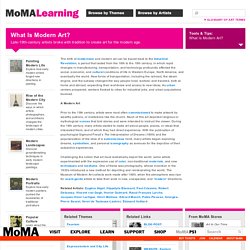
New forms of transportation, including the railroad, the steam engine, and the subway changed the way people lived, worked, and traveled, both at home and abroad, expanding their worldview and access to new ideas. As centers prospered, workers flocked to cities for industrial jobs, and urban populations boomed. A Modern Art Prior to the 19th century, artists were most often to make artwork by wealthy patrons, or institutions like the church. Much of this art depicted religious or mythological that told stories and were intended to instruct the viewer.
I See. Channel. Readymade. African Influences in Modern Art. Surrealism. Cubism. Following their 1907 meeting in Paris, artists Pablo Picasso and Georges Braque pioneered the Cubist , a new vision for a new century that inspired that were initially ridiculed by critics for consisting of “little cubes.”
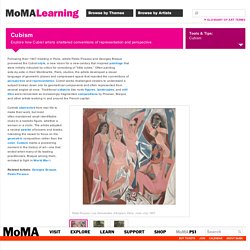
Often painting side-by-side in their Montmartre, Paris, studios, the artists developed a visual language of geometric planes and compressed space that rejected the conventions of and . Cubist works challenged viewers to understand a subject broken down into its geometrical components and often represented from several angles at once. Traditional like nude, landscapes, and were reinvented as increasingly fragmented by Picasso, Braque, and other artists working in and around the French capital. Pablo Picasso. Les Demoiselles d'Avignon. Georges Braque. Pablo Picasso. Cubists from real life to make their work, but most often maintained small identifiable clues to a realistic figure, whether a woman or a violin. 1. The visual or narrative focus of a work of art. German Expressionism.
Abstract expressionism. Abstract Expressionism. The Flesh Eaters, 1952 William Baziotes (American, 1912–1963) Oil and charcoal on canvas; 60 x 72 1/8 in. (152.4 x 183.2 cm) Purchase, George A.
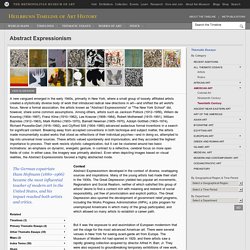
Hearn Fund, Arthur Hoppock Hearn Fund, and Hearn Funds, Bequest of Charles F. Iklé, and Gifts of Mrs. Carroll J. Post and Mrs. George S. A new vanguard emerged in the early 1940s, primarily in New York, where a small group of loosely affiliated artists created a stylistically diverse body of work that introduced radical new directions in art—and shifted the art world's focus. Context Abstract Expressionism developed in the context of diverse, overlapping sources and inspirations. But it was the exposure to and assimilation of European modernism that set the stage for the most advanced American art. Abstract art. Introduction to abstract art The word abstract strictly speaking means to separate or withdraw something from something else.
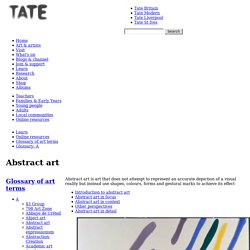
Abstract art is art which is not representational, it could be based on a subject or may have no source at all in the external world. Drawn from reality vs pure abstraction. In pictures: Jackson Pollock – a birthday tribute. Art and artists: artworks. Art and artists: search results. Art and artists: search results. Futurism. Futurism was an art movement launched by the Italian poet Filippo Tommaso Marinetti in 1909.
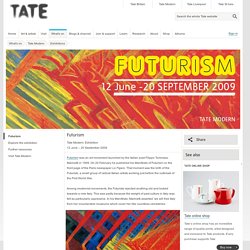
On 20 February he published his Manifesto of Futurism on the front page of the Paris newspaper Le Figaro. That moment saw the birth of the Futurists, a small group of radical Italian artists working just before the outbreak of the First World War. Among modernist movements, the Futurists rejected anything old and looked towards a new Italy. This was partly because the weight of past culture in Italy was felt as particularly oppressive. In his Manifesto, Marinetti asserted ‘we will free Italy from her innumerable museums which cover her like countless cemeteries.’
What the Futurists proposed instead was an art that celebrated the modern world of industry and technology: ‘We declare … a new beauty, the beauty of speed. Tate Modern celebrates the centenary of this dramatic art movement with a ground-breaking exhibition. Estorick Collection of Modern Italian Art. Art Deco.